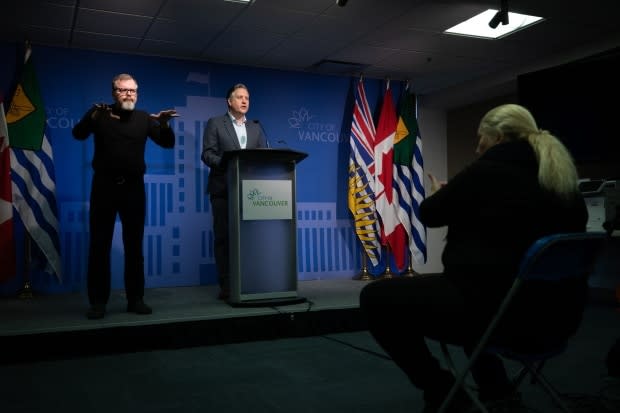Sign language interpreters, fixtures of coronavirus briefings, gain new audience

Ava Hawkins, one of only 15 certified sign language interpreters in B.C., is used to being recognized in the deaf community.
But the 56-year-old was caught off guard last week when walking out of her Vancouver apartment just before 7 p.m.
Applause started to spill out of windows and balconies, a gesture of thanks for health-care workers during the COVID-19 pandemic. Suddenly, a neighbour yelled out to Hawkins, who can hear, from their balcony.
"Hey Ava, congratulations. Well done on TV,'' she recalled the neighbour saying as they applauded.
In recent weeks, Hawkins' profile has skyrocketed under strange circumstances.
Since early March, she has served as an interpreter for the City of Vancouver's coronavirus briefings, using American Sign Language to translate some of the city's more dramatic announcements, including a shutdown of restaurants and bars, and the closure of outdoor public recreation facilities.

She joins a roster of interpreters across Canada who have gained legions of fans thanks to their daily appearances at briefings, and renewed public awareness around sign language.
"For us, it's exciting," said Jodi Birley, the ASL community relations manager at the Wavefront Centre for Communication Accessibility in Vancouver, which provides programs and services for the deaf community.
"Our community and culture are really getting exposure."
Deaf ASL interpreter Tim Mallach signs 11 key terms related to COVID-19:
'Wonderful expressive language'
The interpreters' on-screen appearances have also highlighted gaps in accessibility and a public still new to the nuances of signing.
B.C.'s deaf community is estimated to number 50,000 people, with about 5,000 in the Lower Mainland.
They've typically relied on closed captioning to watch the news. But English is a second language for the deaf, which makes it more difficult to decipher, especially in emergency situations.
"There's not a lot of things in signed languages. So it's very stressful to know what's happening in the world," Birley said.
"We really rely on the announcements to be interpreted, so we can know the severity of the situation and how to help ourselves."
Face and body movements are part of the grammar of sign language, helping convey emotion and tone, which is why interpreters appear so expressive and animated. And it's that energy, in contrast to the stoic officials they stand beside, that has caught the eye of the wider public.

"I can't tell you how much I enjoy the interpreters," wrote Mia Johnson in a response to a CBC News call-out about relying on interpreters. "What a wonderful expressive language."
"Rely on? Not really. But cannot live without them," wrote Roxie Leigh. "Their dedication and enthusiasm are exactly what we all need right now, hearing or not."
Live-stream viewers, however, occasionally pepper misguided jokes about the interpreters or label them a distraction.
"Some people just need to be educated on that," said Jonathan MacDonald, a teacher at the B.C. School for the Deaf in Burnaby.
Technical slip-ups
The 30-year-old, who's deaf, said it's been an exciting time for the deaf community, but noted that the public focus has skewed toward the interpreters' personalties.
"People forget to look at the big picture," he said. "It's the concept behind it that's the priority."
And oftentimes, that service has been marred by technical slip-ups.
Video feeds have suddenly dropped. Interpreters sometimes aren't timed with speakers. And, in one instance, a camera zoomed in on provincial health officer Dr. Bonnie Henry while cutting out the interpreter beside her for 15 minutes.
"It felt very frustrating," MacDonald recalled. "In emergencies, you have to think right away. Sign language is my right-away language, not English."

When she's interpreting, however, Hawkins doesn't see the audience, stripping her of real-time visual cues. Instead, it's her, the mayor, a cluster of city officials and a camera.
During one recent update, a city official started speaking quickly — up to 600 English words a minute, according to Hawkins. (In comparison, B.C.'s health minister speaks about 350 words a minute).
"We joke about it because I was sweating. It was so fast," Hakwins laughed.
At another point, a city staffer nearly recited all the addresses of newly installed hand washing stations in the Downtown Eastside — an "interpreter's nightmare," Hawkins said, as the signer would normally use street corners.
ASL recognition a first step
But officials are starting to get accustomed to the interpreters. The city staffer who spoke quickly, Hawkins said, noticeably slowed down the following week.
The public, too, has come to expect the interpreters and will often note their absences. Support for Nigel Howard, the ASL interpreter featured at the daily provincial updates, has morphed into a Facebook fan club.
"I think even the deaf community is kind of stunned and surprised at some of the attention that the interpreters are getting," said Hawkins, who grew up in a deaf family in Winnipeg.

She hopes that recognition will mean greater accessibility measures and more deaf people having a voice on the public stage.
At the city's most recent coronavirus update, Hawkins assumed a role behind the scenes. She translated the mayor's remarks for her deaf colleague, Tim Mallach, as he interpreted for the camera.
"Some of us are like chocolate ice cream and some of us are like strawberry," Hawkins later said.
"It's really lovely to see that the community can actually pick the flavour they want."

